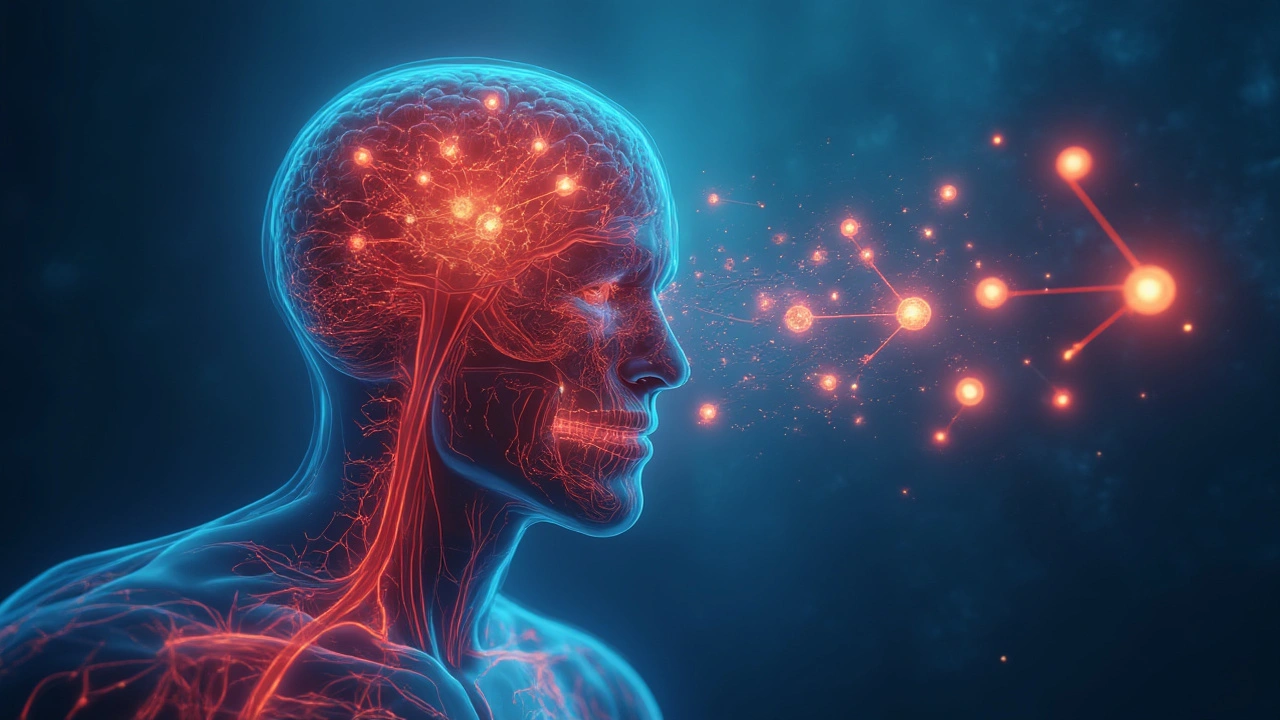Pain throws us off, fast. A pounding headache, a twisted ankle, or a throbbing toothache will turn the toughest plans into an afterthought. But pop a painkiller — and poof, the misery fades. Or does it? What exactly happens between swallowing that pill and actually feeling better? The way painkillers work in your body is both wild and way more complicated than most people imagine. There’s no tiny ninja in each tablet zapping pain signals. Instead, it’s a dance between brain chemistry, hidden body clocks, and molecules hijacking the messaging system between your cells. And no, not all painkillers play by the same rules. Ready to lift the lid on how pain relief really works?
Why We Feel Pain In the First Place
Break your big toe by stubbing it against a coffee table, and a super-speedy wave of tiny electrical impulses starts firing. Special nerve endings around your body (called nociceptors) spot damage or even the threat of damage. They’re really just sensors—like smoke alarms, only microscopic and far more dramatic. As soon as these nerves register trouble, they shoot off a signal. That message races up your spinal cord straight to your brain. Your brain then decides, “Ow, this is pain — do something about it!”
Here’s a twist: not every signal becomes a conscious ‘ouch.’ Sometimes your brain blocks low-level pain if it’s not a life-or-death situation. Stress, genetics, and even your mood can raise or lower this pain “volume.” For example, marathon runners sometimes report not feeling blisters until after the race — their bodies literally file the pain report later.
All pain isn’t equal, either. You feel burning, aching, or sharp stabbing vibes thanks to different types of nerve fibers. C fibers handle dull, lingering aches, while A-delta fibers do the fast, sharp response. The signals themselves use chemical messengers called neurotransmitters, like glutamate or substance P, to talk to each other. These are what painkillers try to intercept or muffle.
If you’re always reaching for painkillers, knowing how pain works can help you dodge the ‘pill cycle’ and try other pain-breaking tactics, like mindfulness, heat packs, or even movement.
Unlocking the Secret: How Painkillers Block Pain
Painkillers wear a bunch of different hats. Some block the pain messages from being sent. Others stop your brain from actually receiving or interpreting those signals. And some do a bit of both. There are three main families of painkillers: nonsteroidal anti-inflammatory drugs (NSAIDs), paracetamol (acetaminophen), and opioids. They each work differently in your body, and that difference really matters when you need relief.
NSAIDs — think ibuprofen or aspirin — are the everyday heroes. They work by blocking an enzyme in your body called cyclooxygenase, or COX. When you get hurt, this enzyme helps produce prostaglandins, which are inflammatory chemicals that make nerves sensitive and send more pain signals to your brain. NSAIDs throw a wrench in the COX machine, slashing the production of prostaglandins, and with fewer prostaglandins floating around, nerves chill out and pain decreases — along with swelling.
Paracetamol (acetaminophen) is sneaky. Scientists still argue about exactly how it works. Instead of shutting down prostaglandins throughout your whole body, it mostly tamps down pain and fever in your brain, likely by boosting your own internal painkillers called endocannabinoids or affecting the COX enzyme just in the brain. It’s well tolerated and skips the stomach side effects you might get with NSAIDs, but don’t let that fool you into thinking it’s harmless. Too much paracetamol and your liver will go on strike fast.
Opioids like oxycodone, tramadol, or morphine are heavyweight champions — but with a dark side. They look like natural chemicals your brain already uses to dull pain — called endorphins — and stick themselves to opioid receptors on your nerve cells. This basically blocks pain messages right at the nerve 'switchboard' and tells your body to feel good, sometimes even a little euphoric. Here’s the catch: use them often, and your body stops making its own endorphins. The risk of dependence is real and rises with every extra pill.
Here's a table breaking down how these three big types of painkillers work and their major effects:
| Painkiller Type | Main Mechanism | Pain Relief For | Risks |
|---|---|---|---|
| NSAIDs (ibuprofen, aspirin) | Blocks COX enzymes, lowers prostaglandins | Inflammation, headaches, sprains | Stomach ulcers, kidney issues |
| Paracetamol (acetaminophen) | Acts in brain/blocks pain signal, lowers fever | Headaches, fever, mild pain | Liver damage if overused |
| Opioids (morphine, codeine) | Docks at opioid receptors, blocks pain messages | Surgery, cancer pain, serious injuries | Addiction, drowsiness, constipation |
If you want the fastest pain relief, time matters. Medications like ibuprofen usually start kicking in within 20-30 minutes, but don’t always last more than six hours. Paracetamol is similar, while opioids work quicker if injected but last longer by mouth. Never mix and match without asking a healthcare pro — some combos, like NSAIDs plus paracetamol, are safe for short-term use, but stacking painkillers can lead straight to the ER.

Surprising Facts: What You Didn’t Know About Painkillers
Thinking painkillers are a magic fix? Let’s reset the record. NSAIDs like ibuprofen are among the most-used medications in the world, but taking them every day doubles your chance of stomach trouble in just a couple weeks. And did you know that paracetamol is the leading cause of acute liver failure in some countries? That’s a lot of risk hiding in your medicine cabinet.
But the plot thickens: your genes can decide whether a painkiller helps or not. For instance, about 10% of people of European descent are slow ‘metabolizers’ for codeine — meaning, their bodies barely convert it into the active painkiller morphine, so it hardly works at all. On the flip side, some people break it down super quickly, risking overdose even at normal doses. Researchers are now working on painkiller prescriptions custom-fitted to your DNA.
Ever taken a painkiller and… nothing happens? Food, caffeine, and whether you’ve slept well all affect how strongly the meds work. Swallow ibuprofen with a burger, and it slows the med’s entry into your bloodstream, dragging out the relief. Caffeine, on the other hand, can boost the pain-killing effect of some drugs — that’s partly why it’s in some headache pills.
There’s more: pain is weirdly subjective. A study at Oxford found that people who believed a painkiller would “definitely not work” needed almost twice the dose to get the same effect as those who believed it would help. So, your brain isn’t just affected by the drug — your expectations matter, too.
Here are a few key tips for using painkillers smarter:
- Never double up brands — check the active ingredient. Accidentally mixing two meds with the same base (like two ibuprofen brands) amps up side effects fast.
- Set a timer. Jot down the time you took your medicine, especially during bad colds or migraines, to avoid accidentally re-dosing too soon.
- Eat before taking NSAIDs — even a small snack shields your stomach lining.
- Watch your total intake over 24 hours. For paracetamol, the safe upper limit in adults is about 4,000 mg (that’s eight 500mg pills — check packaging!). For ibuprofen, it’s about 3,200 mg.
Long-term pain? Don’t use painkillers as a crutch for more than a few days without asking your doctor what’s really going on. Chronic pain deserves a strategy, not just a medicine cabinet jammed full of pills.
From Breakthroughs to the Future: What’s Next for Painkillers?
We’ve come a long way from chewing willow bark — which, by the way, is how aspirin first started. But pain medicine is at a turning point. Researchers are hunting for drugs that bring relief without the baggage of addiction or nasty side effects. One hot topic: drugs that block a very specific sodium channel in nerves, called Nav1.7, which seems to decide whether you even feel pain at all. People with a faulty Nav1.7 gene literally don’t get hurt, no matter what—scientists are now aiming to mimic that effect safely.
There’s also buzz around ‘nano’ painkillers, super-tiny particles that can deliver drugs directly to injured areas, cutting side effects on the rest of your body. Imagine a future pain pill that only targets your twisted ankle — ignoring your healthy organs!
People with chronic pain are starting to find hope in treatments that go beyond pills. New combinations of old painkillers with nerve-calming drugs, personalized dosing using saliva tests, and even VR therapy for reducing pain perception are moving out of labs and into real life. There’s even research into how gut health can mess with pain signaling — so taking care of your microbiome might just change how you experience pain in the first place.
The wildest fact? Many of the world’s painkillers were discovered by accident. Morphine came from poppy sap during experiments for sleep aids; aspirin started as a cure for Dad’s sore joints in rural England. But better pain relief isn’t just about chemicals or clever inventions — it’s about listening to your pain, finding the best fit for your own biology, and knowing when to ask for help. Because that’s where the real healing starts.

